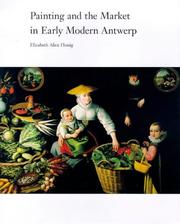| Listing 1 - 3 of 3 |
Sort by
|

ISBN: 0300072392 Year: 1998 Publisher: New Haven (Conn.) : Yale university press,
Abstract | Keywords | Export | Availability | Bookmark
 Loading...
Loading...Choose an application
- Reference Manager
- EndNote
- RefWorks (Direct export to RefWorks)
Painting --- trade [function] --- History of Antwerp --- art market --- Iconography --- markets [events] --- Vranckx, Sebastiaan --- Snyders, Frans --- Beuckelaer, Joachim --- Aertsen, Pieter --- Bruegel, Jan [Elder] --- Mostaert, Gillis [Elder] --- anno 1600-1699 --- anno 1500-1599 --- Antwerp --- markten --- economie --- handel --- 16de eeuw --- 17de eeuw --- Antwerpen --- 7.075 --- 75 <493 ANTWERPEN> --- Kunsthandel. Kunstbemiddeling. Activiteiten van promotors; managers; producers --- Schilderkunst--België--ANTWERPEN --- Art and society --- Painting, Modern --- Values --- History --- Marketing. --- 7.075 Kunsthandel. Kunstbemiddeling. Activiteiten van promotors; managers; producers --- 75 <493 ANTWERPEN> Schilderkunst--België--ANTWERPEN --- Marketing --- Axiology --- Worth --- Aesthetics --- Knowledge, Theory of --- Metaphysics --- Psychology --- Ethics --- Oil painting --- Painting, Primitive --- Paintings --- Graphic arts --- Art --- Art and sociology --- Society and art --- Sociology and art --- Social aspects --- Belgium --- Antwerp (Belgium) --- 16th century --- 17th century --- markten. --- economie. --- handel. --- Aertsen, Pieter. --- 16de eeuw. --- 17de eeuw. --- Antwerpen. --- trade [general function] --- marktstukken --- Antwerpse school
Book
ISBN: 9781789140767 1789140765 Year: 2019 Publisher: London Reaktion Books
Abstract | Keywords | Export | Availability | Bookmark
 Loading...
Loading...Choose an application
- Reference Manager
- EndNote
- RefWorks (Direct export to RefWorks)
In sixteenth-century Northern Europe, during a time of increasing religious and political conflict, Flemish painter Pieter Bruegel explored how people perceived human nature. Bruegel turned his critical eye and peerless paintbrush to mankind's labors and pleasures, its foibles and rituals of daily life, portraying landscapes, peasant life, and biblical scenes in startling detail. Much like the great humanist scholar Erasmus of Rotterdam, Bruegel questioned how well we really know ourselves and also how we know, or visually read, others. His work often represented mankind's ignorance and insignificance, emphasizing the futility of ambition and the absurdity of pride. This superbly illustrated volume examines how Bruegel's art and ideas enabled people to ponder what it meant to be human. Published to coincide with the four-hundred-fiftieth anniversary of Bruegel's death, it will appeal to all those interested in art and philosophy, the Renaissance, and Flemish painting -- éd.
Philosophical anthropology --- Folklore --- Bruegel, Pieter [Elder] --- Painting --- humanism --- Painters --- Painting, Flemish --- Painting, Renaissance --- Humanity in art --- Bruegel, Pieter, --- Themes, motives. --- Painting, Flemish. --- Painting, Renaissance. --- Humanity in art. --- Painters. --- 21.02 history of painting. --- 1500-1599. --- Belgium. --- Caractéristiques humaines --- Homme --- Dans l'art --- Bruegel, Pieter --- Thèmes, motifs. --- 75.07 --- Schilderkunst ; Zuidelijke Nederlanden ; 16de eeuw ; Pieter Bruegel (de Oude) --- Schilderkunst ; schilders A-Z --- 75 BRUEGEL, PIETER --- 75 BRUEGEL, PIETER Schilderkunst--BRUEGEL, PIETER --- Schilderkunst--BRUEGEL, PIETER --- Caractéristiques humaines --- Thèmes, motifs. --- schilderkunst, Nederlanden
Book
ISBN: 9780271071084 0271071087 Year: 2016 Publisher: University Park, Pennsylvania The Pennsylvania State University Press
Abstract | Keywords | Export | Availability | Bookmark
 Loading...
Loading...Choose an application
- Reference Manager
- EndNote
- RefWorks (Direct export to RefWorks)
Unlike the work of his contemporaries Rubens and Caravaggio, who painted on a grand scale, seventeenth-century Flemish painter Jan Brueghel’s tiny, detail-filled paintings took their place not in galleries but among touchable objects. This first book-length study of his work investigates how educated beholders valued the experience of refined, miniaturized artworks in Baroque Europe, and how, conversely, Brueghel’s distinctive aesthetic set a standard—and a technique—for the production of inexpensive popular images. It has been easy for art historians to overlook the work of Jan Brueghel, Pieter’s son. Yet the very qualities of smallness and intimacy that have marginalized him among historians made the younger Brueghel a central figure in the seventeenth-century art world. Elizabeth Honig’s thoughtful exploration reveals how his works—which were portable, mobile, and intimate—questioned conceptions of distance, dimension, and style. Honig proposes an alternate form of visuality that allows us to reevaluate how pictures were experienced in seventeenth-century Europe, how they functioned, and how and what they communicated. A monumental examination of an extraordinary artist, Jan Brueghel and the Senses of Scale reconsiders Brueghel’s paintings and restores them to their rightful place in history.
Painting --- easel paintings [paintings by form] --- Bruegel, Jan [Elder] --- anno 1600-1699 --- anno 1500-1599 --- Flanders --- Small painting, Flemish --- Small painting, Flemish. --- Malerei. --- Bruegel, Jan, --- Brueghel, Jan, --- Criticism and interpretation. --- 1500-1699. --- Bruegel, Jan --- Critique et interprétation.
| Listing 1 - 3 of 3 |
Sort by
|

 Search
Search Feedback
Feedback About UniCat
About UniCat  Help
Help News
News